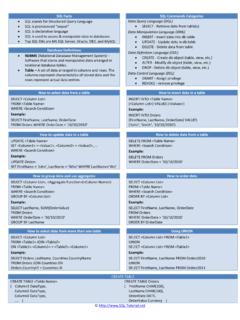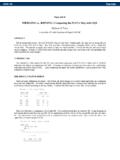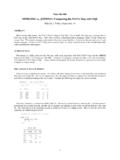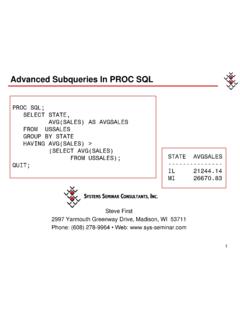Transcription of 031-30: What Would I Do without PROC SQL and the Macro ...
1 1 PAPER 031-30 WHAT Would I DO without PROCSQLAND THE Macro LANGUAGEJeff Abolafia, Rho, Inc., Chapel Hill, NCIntroductionThe SAS Macro language used in conjunction with PROC SQL provides the programmer a powerful set of tools for building effectiveand efficient applications. These tools can be utilized for a wide range of applications only limited by one s imagination. In this paper, we present a series of examples taken from several real world applications. These examples demonstrate a more efficient approach to common tasks using the Macro language in combination with PROC PROC SQL with the Macro LanguageMost SAS users Would agree that PROC SQL is an effective tool for building applications.
2 Combining PROC SQL with the Macro language interface increases the functionality of PROC SQL and allows us to build more robust and efficient applications. PROC SQL provides the INTO and SEPARATED BY statements for interfacing with the Macro language . The INTO option for the SELECT statement can store the value of a variable, constant, calculation, or expression in one or more Macro variables. The SEPARATED BY option allows the user to assign all of the values of an entire column to a Macro variable. A delimiter chosen by the user separates values.
3 For a more complete description of these two statements see SAS Macro language : Reference, First Edition (1997). Building applications using PROC SQL and the Macro language offers several efficiencies compared with alternative approaches: 1) in a single PROC you can obtain summary statistics and store them in one or more Macro variables; 2) the code to store the contents of an entire column in a Macro variable is less complex than in a data step; 3) Dictionary tables can only be accessed by PROC SQL (dictionary views can be accessed without PROC SQL).
4 4) in many cases, SAS code can be generated more efficiently and dynamically than in a data 1: Storing Ns in Macro Variables When producing data displays, we typically report the number of observations in various subgroups or the total number of observations. These statistics are usually displayed in titles, footnotes, or columns headers. The traditional approach is to execute PROC MEANS to get observations counts and then to use a data step with CALL SYMPUT to store the observation counts in Macro variables. Example one shows a more efficient approach using PROC SQL and the Macro language .
5 Example 1proc sql noprint;select n(drug) into :n1 -:n2 from analgroup by drug ;quit;proc format ;value $cft 1 = "Drug (N = &n1) "2 = "Placebo (N = Run; Coders' CornerSUGI30 2 The SQL code in Example 1 uses the SELECT and INTO statements to store the number of observations in each of the two drug groups in two Macro variables. These Macro variables are then used in a subsequent step to display the number of observations in column headers. Example 2: Storing Counts in Macro VariablesExample 2 extends the concepts presented in Example 1.)
6 While Example 1 shows how to store frequency counts of a given variable into Macro variables, Example 2 demonstrates how to store counts of observations meeting any criteria in one or more Macro variables. In this example we use the SUM function to count the number of males where Drug=1, Drug=2, and Drug = 1 or 2. These counts are then stored in three Macro variables using the INTO statement. Example 2proc sql noprint;select sum(drug=1),sum(drug=2),sum(1<=drug<=2) into :n1,:n2,:n3 from analwhere gender= Male ;quit; Example 3: Print from Every Dataset in a LibraryThere is often a need to print selected records from every dataset in a library.
7 For example we may want to produce a data dump of all subjects with cardiovascular disease. One approach Would be to first run aprogram to output subjects with cardiovascular disease (CVD). Then merge this file with each dataset in our library, keeping only subjects with cardiovascular disease and then running a PROC PRINT on each of these datasets. While this works, it is extremely cumbersome and requires a priori knowledge of all data set names in our library. Example 3 demonstrates a more efficient and dynamic SQL is used to create two lists that are stored in Macro variables.
8 Macro variable IDS is created from the dataset containing CVD information and contains a comma-separated list of subjects with a history of CVD. This list is used to filter observations to PROC PRINT. The second Macro variable, DSNS, is created from and contains a list ofdatasets in our library. Once these two Macro variables are created, Macro PRINTIT can be used to list subjects in each dataset with 3 demonstrates one of the strengths of using SQL with the Macro language the ability to easily store listsor the contents of an entire column in a Macro variable.
9 In this example we store both the list of IDS and the list of datasets in Macro variables. In each case this is done with a single statement. The code using this method is much less complex than thecode using a Data step. To accomplish the same task with a Data step we Would have to: 1) create a new variable; 2) use the RETAIN statement to declare the variable a retained variable; 3) use an assignment statement to load the contents of a column into the retained variable; 4) use the END= dataset option to identify the last record; and 5) at the last record use CALL SYMPUT to load the contents of the retained variable into a Macro variable.
10 Example 3libname VACC 'S:\RHO\VASOCOR\VVS_Acc\data\crf' ;proc sql noprint;select quote(trim(id)) into :ids separated by ','from where CVDYN='Y' ;Coders' CornerSUGI30 3select memname into :dsns separated by ' 'from libname="VACC";quit;%put IDs with CVD are: %put datasets in VACC are: /* SAS LOG IDs with CVD are:"1581","1587","1588","1600","1606"," 1619","1621","2522","2533","2558", "2571","2577"dataets in VACC are: CHEMMSTR CMEDMSTR DEMOMSTR ECG1 MSTR ECHOMSTR EXERMSTREND of SAS LOG*/% Macro printit ;%let i =1 ;%do %until (%scan(&dsns, %let dsn = %scan( proc print data= Vacc.)))

















